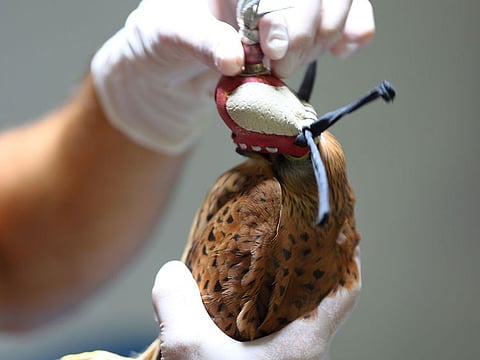Why NYU Abu Dhabi researchers are studying the evolution of falcons
Findings point to how new species of birds, mammals emerge, adapt to the environment

Abu Dhabi: A team of researchers at NYU Abu Dhabi (NYUAD) has discovered a strong link between how a genome is structured and how a species evolves by studying the genomic architecture of several falcon species.
The researchers’ newly-developed falcon genomes and findings of unique evolutionary patterns could make falcons a model for the study of the links between genomic evolution, speciation and environmental adaption.
The research was led by postdoctoral associate and evolutionary biologist Justin Wilcox.
Why falcons?
Falcons are an ideal model for studying the process of evolution as there is an ongoing emergence of new falcon species and extreme variation in environments and habitats that falcons occupy, the university said. Additionally, falcons have a unique genomic arrangement relative to other animals, including other birds.
Falcons are important species to the culture, commerce, and conservation efforts in the Middle East and North Africa region, but this study’s findings suggest that falcons may also have a special role to play in illuminating how and why genetic material is organised in the way that it is.
New paper
In a new paper titled ‘Linked-Read Sequencing of Eight Falcons Reveals a Unique Genomic Architecture in Flux’, Wilcox and colleagues presented new genomes for eight falcons, and analysed how the unique genomic structure of falcons has influenced their evolution. The researchers found that falcon genomes are now evolving in a way that is more similar to processes observed in mammals. Specifically, they report falcons as the first birds that demonstrate an evolutionary process known as AT-GC disequilibrium, which is previously only well-documented in mammals.
The team sequenced the genome of the lanner falcon for the first time in the species’ history, in addition to producing two new genomes for gyrfalcons, three new genomes for peregrine falcons – including the first-ever reference genomes for two peregrine subspecies -- and a new genome for the saker falcon and the common kestrel. Together, these species represent all the falcon species most commonly used in falconry.
“Falcons are unique in the speed and success with which they have spread across the globe and colonised new environments. Our findings highlight that their evolution is also unique among birds at the molecular level. This research also leads the way for the future study of falcon genomes to improve ancestry tests and hybrid detection, genomic trait mapping, and determination of genomic differences between species,” Wilcox said.
Sign up for the Daily Briefing
Get the latest news and updates straight to your inbox







